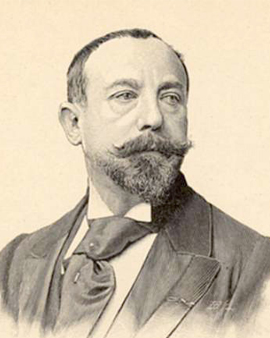Léon-François Comerre, born October 10, 1850 in Trélon, France, and died in 1916 in Le Vésinet, was a renowned Symbolist artist and a master of academic painting. An uncle of the renowned Albert Gleizes, Comerre occupied an equally notable place in art history.
Comerre received his artistic training in Lille and at the famous École des Beaux-Arts in Paris. There he came through the painter Alexandre Cabanel.
(1823-1889) brought him into contact with Orientalism. Comerre's work was varied and included portraiture, depictions of odalisques, and mythological and historical scenes. His style and subjects were based on a transfigured Symbolism and the Pre-Raphaelites, while he found an independent, artistic expression. Between 1874 and 1875, Comerre presented his works at the Paris Salon, winning the coveted Prix de Rome in 1875 for his painting "L'Annonce aux bergers." This success opened the doors to international exhibitions for him. In the years that followed, he lived in London and exhibited his work at the Royal Academy of Arts and at the Royal Glasgow Institute of the Fine Arts in Glasgow.
Comerre was a remarkable painter of the 19th and early 20th centuries, whose work can still be admired in museums worldwide. His style, influenced by academic art and orientalism, left a strong impression on the art world. His most significant works, including "Pierrot playing the mandolin" and "The Flood," are lasting testaments to his masterful skills. Comerre was highly decorated for his work, including a knighthood in the French Legion of Honor and an officer's dignity in the Legion of Honor. His legacy lives on today, not only in the hearts of art lovers, but also in the numerous fine art prints of his works that can be found in collections around the world.
×





.jpg)
.jpg)
.jpg)
.jpg)
.jpg)
.jpg)
.jpg)
.jpg)
.jpg)
.jpg)
.jpg)
.jpg)
.jpg)
.jpg)
.jpg)
.jpg)
.jpg)
.jpg)
.jpg)
.jpg)
.jpg)
.jpg)
.jpg)
.jpg)
.jpg)
.jpg)
_-_(MeisterDrucke-1517507).jpg)
_-_(MeisterDrucke-1517507).jpg)
.jpg)
.jpg)
.jpg)
.jpg)
 - (MeisterDrucke-229317).jpg)
 - (MeisterDrucke-229317).jpg)
.jpg)
.jpg)
.jpg)
.jpg)
.jpg)
.jpg)
.jpg)
.jpg)
.jpg)
.jpg)
.jpg)
.jpg)
.jpg)
.jpg)
.jpg)
.jpg)
.jpg)
.jpg)
.jpg)
.jpg)
.jpg)
.jpg)






